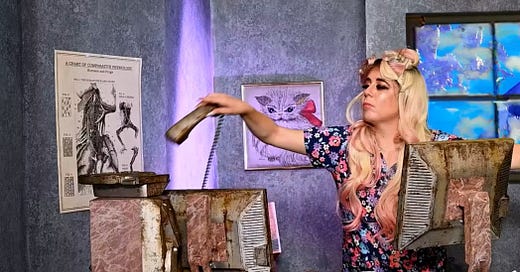Ego Deflation in Video Art
Jake Brush, Alex Bag, Michael Bell-Smith, Lizzie Fitch, and Ryan Trecartin
Ego Deflation and Video Art as Degrowth Politics
EAI x International Objects: An Evening With Jake Brush (May 24, 2024)
Rosalind Krauss identified the condition of video art in the 1970s as narcissism, based on the tendency of artists to picture themselves behind the camera, punctuated between recursive loops and other temporal processes of the nascent technology. It’s hard to deny that narcissism has now become the dominant condition of moving-image media production today: from TikTok to Patreon, everyone has turned themselves into their own brand, whether as a makeup influencer, like-and-subscribe storyteller, self-help guru (of which there are now more than a handful in the arts), or social-justice advocate. It seems like the one simple trick to achieving some commercial reward in the current information economy is to turn the camera on oneself. But economic growth doesn’t take the shape of a hockey stick—eventually these forms of self-branding will be metabolized within capitalism as it shifts to new forms of commodification. What will happen to me-media?
Jake Brush’s videos hint at a possible future, populated by down-on-their luck influencers and geriatric nepo babies. The digital and DIY Laundry Detergent (Cheers)! (2023) features the melting, masked faces of an aging Real Housewives-type trio of alcoholic frenemies, including a laundry heiress who claims she was so rich she could buy as much makeup as she wanted. Whether you wonder what happens to old punks when they die or what will become of the tightened faces of pop stars, the answer is probably that they’ll deflate, prune-like, repeating the same tired catchphrases on loop. Both the ego and the body will suffer the impact of gravity. Literal deflation is also a minor theme in Petpourri (2023), a loose narrative telling of a job interview gone awry for a pet-loving genetic clone of pet-culture celebrity Marc Morrone. Set in a world where flushing a goldfish down the drain will get you murdered, the protagonist (played by Brush) seems to live in a quasi-hallucinated state of awareness where “all domesticated animals are just computer animated.” During the job interview, they recount a deceptive tale about the two testicular-like glands attached to their face, and which inflate and deflate at various points throughout the 20-minute video.
All this deflation could be soul crushing if it weren’t for the sheer color and absurdity from Brush’s productions, all of which consist of handmade horror-film effects worn by friends-and-family-turned-actors, as well as lo-fi but detailed software modeling. It used to be so much fun, to take out a video camera or use non-specialized software to make up or mash-up stories and weirdo abstractions with friends based on pre-existing genres and materials. As Jake mentioned in the screening Q&A, now everyone can make and edit their own videos in social-media apps. But even the ugly filters are still too sleek and the effects more homogenous than particular as one sifts calmly, as if hypnotized, through the scroll of recommendations.
It’s clear to see the other works included by Brush in the EAI screening (Alex Bag, Lizzie Fitch and Ryan Trecartin, and Michael Bell-Smith) as predecessors. They all share through-lines of a critical play with genre and amateurism—even when skilled—disrupted through forms of emphatic yet wholly unempathetic dialogue. In the case of Michael Bell-Smith’s Chapters 1–12 of R. Kelly’s Trapped in the Closed Synced and Played Simultaneously (2005), that disruption takes place through a “failed hypnosis” (Jake’s term) with celebrity, substituted with a Rococo spectacle following a similar rhythmic musical structure.
What do we do with the ego now that it’s been deflated? While it might not seem obvious, degrowth is necessary. As capitalism continues its metabolic shift on social media to eat up all that one has, from the right to privacy to autonomous action, video art simulates the absurdity of an ever-expanding world of me-media that asks for the continued extraction of resources from the self. Refusal of the dominant system can be difficult or impossible, but there are those expressing the need for other ways of being—this time with friends, not fans.
Thanks for reading my free and quickly typed newsletter. There’s always typos and sentences that could be improved upon.
Extra: So many more names can be added to the list of artists and others invested in the absurdity of ego extractive forces by denying the benefits of accumulation, often through a mix of DIY and digital effects—Shana Moulton and her recent show at MoMA would be a top addition.
More extra: I liked to make DIY videos in middle school, inclduing when I made a talk show for my book report about Chernowitz. One of my sisters nearly derailed the shoot by going off script with a song about clog dancing. The summer after my undergrad, I was a very minor participant in Nohegan Horror, a video that shows off my poor acting skills and my poorly constructed wound made from a mix of petroleum jelly, food coloring, and coffee grinds. Cauleen Smith’s hot-dog entrails might be the best part.




